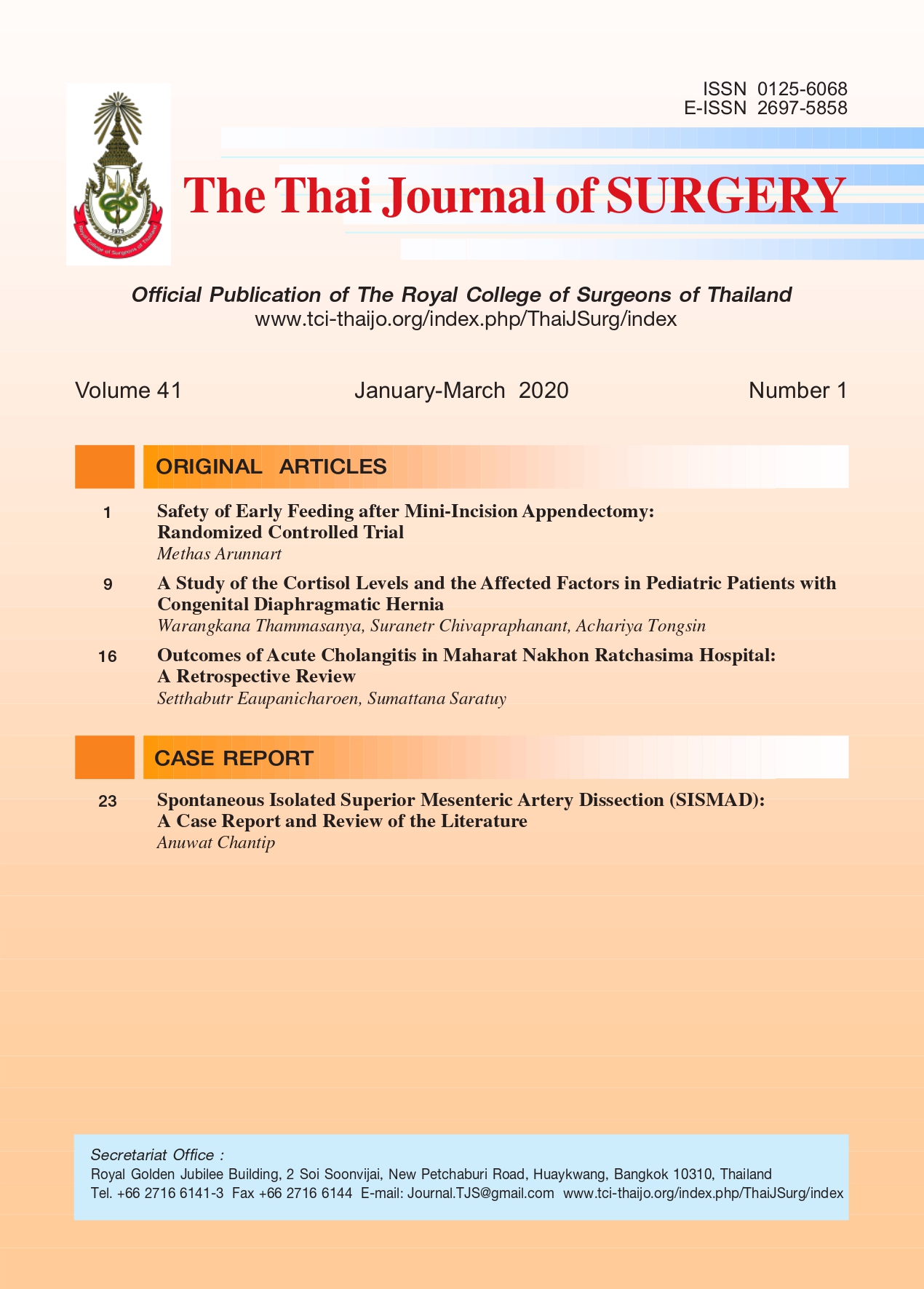Outcomes of Acute Cholangitis in Maharat Nakhon Ratchasima Hospital
A Retrospective Review
Keywords:
CholangitisAbstract
Introduction: Acute cholangitis is a common biliary tract infection which has a high mortality rate, especially in severe cholangitis. The recommended treatments are emergent or urgent biliary drainage. The therapeutic procedure of choice is endoscopic retrograde cholangiopancreatography (ERCP). The second choice is percutaneous biliary drainage (PTBD) and surgical biliary decompression. Due to the limited resources for ERCP and radiologists that may perform PTBD in the Maharat Nakhon Ratchasima Hospital (MNRH), the aim of this study was to review the outcomes of cholangitis treatment and factors associated to mortality in MNRH.
Meterials and Methods: This study reviewed medical records of all patients who were newly diagnosed with acute cholangitis at Maharat Nakhon Ratchasima Hospital between January 1st, 2017 and December 31st, 2017. Logistic regression was used to analyze factors associated with mortality and effect size was reported as odds ratio with 95% confidence interval. A p-value less than 0.05 was considered as statistically significant.
Results: The medical records review of 250 acute cholangitis patients indicated that the overall mortality was 11.2% (almost all of whom had severe acute cholangitis). The overall mortality rates of patients who were treated by minimally invasive biliary drainage, antibiotics alone, or open surgical drainage were 4.6%, 10.7% and 31.6% respectively. Independent factors associated with mortality were severe acute cholangitis (OR= 61.20; 95% CI: 7.84 to 478; p < 0.01), surgical drainage (OR= 6.60; 95% CI 1.30 to 33.48; p = 0.02), and non-stone etiology (OR= 4.07; 95% CI 1.28 to 12.94; p = 0.02).
Conclusion: Minimally invasive biliary drainage should be a procedure of choice for biliary drainage in acute cholangitis due to its lower mortality compared to open surgical drainage. Open surgical drainage should be reserved when other preferred methods are not available.
References
Lan Cheong Wah D, Christophi C, Muralidharan V. Acute cholangitis: current concepts in acute cholangitis. ANZ J Surg 2017;87:554–9.
Rumsey S, Winders J, MacCormick AD. Diagnostic accuracy of Charcot’s triad: a systematic review. ANZ J Surg. 2017;87:232–8.
Miura F, Okamoto K, Takada T, et al. Tokyo Guidelines 2018: initial management of acute biliary infection and flowchart for acute cholangitis. J Hepato-Biliary-Pancreat Sci 2018;25:31–40.
Welch JP, Donaldson GA. The urgency of diagnosis and surgical treatment of acute suppurative cholangitis. Am J Surg 1976;13:527–32.
O’Connor MJ. Acute bacterial cholangitis: An analysis of clinical manifestation. Arch Surg 1982;117:437-41.
Boey JH, Way LW. Acute cholangitis. Ann Surg 1980;191:264–70.
Gigot JF, Leese T, Dereme T, et al. Acute cholangitis. Multivariate analysis of risk factors. Ann Surg 1989;209:435–8.
Lai EC, Tam PC, Paterson IA, et al. Emergency surgery for severe acute cholangitis. The high-risk patients. Ann Surg 1990;211:55–9.
Lai EC, Mok FP, Tan ES, et al. Endoscopic biliary drainage for severe acute cholangitis. N Engl J Med 1992;326:1582–6.
Tan M, Schaffalitzky de Muckadell OB, Laursen SB. Unchanged mortality in patients with acute cholangitis despite an increase in malignant etiologies – a 25-year epidemiological study. Scand J Gastroenterol 2019;54:335–41.
Gomi H, Takada T, Hwang T-L, et al. Updated comprehensive epidemiology, microbiology, and outcomes among patients with acute cholangitis. J Hepato-Biliary-Pancreat Sci 2017;24:310–8.
Sharma B, Kumar R, Agarwal N, Sarin S. Endoscopic biliary drainage by nasobiliary drain or by stent placement in patients with acute cholangitis. Endoscopy 2005;37:439–43.
Rahman SH, Larvin M, McMahon MJ, Thompson D. Clinical presentation and delayed treatment of cholangitis in older people. Dig Dis Sci 2005;50:2207–10.
Lee C-C, Chang I-J, Lai Y-C, et al. Epidemiology and prognostic determinants of patients with bacteremic cholecystitis or cholangitis. Am J Gastroenterol 2007;102:563–9.
Tsujino T, Sugita R, Yoshida H, et al. Risk factors for acute suppurative cholangitis caused by bile duct stones: Eur J Gastroenterol Hepatol 2007;19:585–8.
Yuk Pang Y, Andrew Wai Chun Y. Predictors for emergency biliary decompression in acute cholangitis: Eur J Gastroenterol Hepatol. 2006l;18:727–31.
Agarwal N. Endoscopic management of acute cholangitis in elderly patients. World J Gastroenterol 2006;12:6551.
Nagino M, Takada T, Kawarada Y, et al. Methods and timing of biliary drainage for acute cholangitis: Tokyo Guidelines. J Hepatobiliary Pancreat Surg 2007;14:68–77.
Downloads
Published
How to Cite
Issue
Section
License
Articles must be contributed solely to The Thai Journal of Surgery and when published become the property of the Royal College of Surgeons of Thailand. The Royal College of Surgeons of Thailand reserves copyright on all published materials and such materials may not be reproduced in any form without the written permission.



